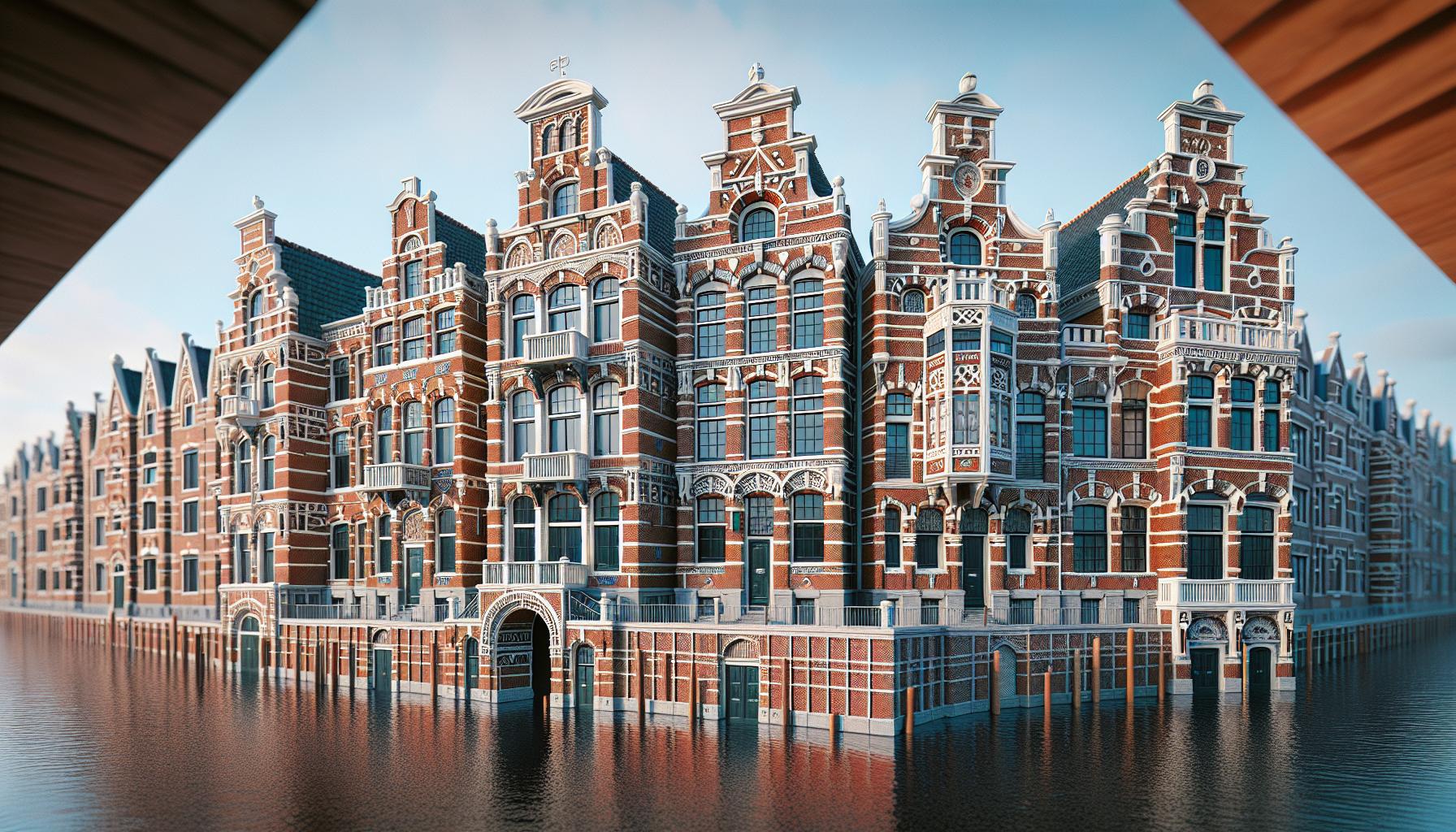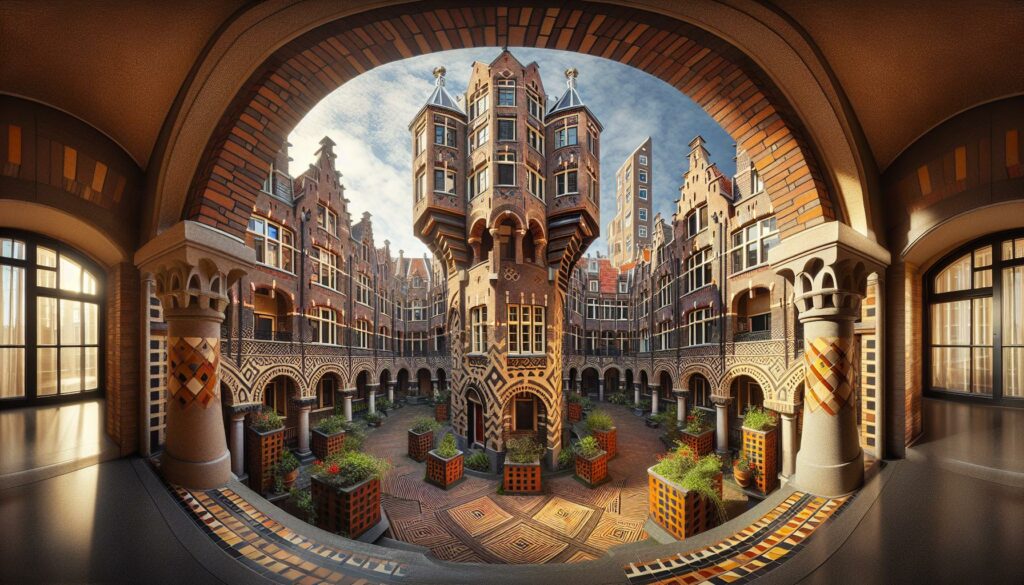Tucked away in the heart of Rotterdam’s historic district lies a hidden architectural gem – the Wilbertemhof Marijneverpoort. This stunning residential complex stands as a testament to Dutch urban planning and social housing innovation from the early 20th century.
With its distinctive red-brick façade and intricate archways the Wilbertemhof Marijneverpoort has become more than just a collection of apartments. It’s a living museum that tells the story of Rotterdam’s resilience and architectural evolution. The complex’s unique blend of Art Nouveau and traditional Dutch design elements continues to captivate visitors and architecture enthusiasts from around the globe. While many historic buildings fell during World War II this remarkable structure survived to become one of Rotterdam’s most cherished landmarks.
Wilbertemhof Marijneverpoort
The Wilbertemhof Marijneverpoort district stands as a testament to Rotterdam’s architectural heritage, featuring interconnected courtyards bordered by distinctive residential buildings. Cultural elements throughout the neighborhood showcase the original 1908 craftsmanship, including decorative stonework embellishments around windows and ornate wrought-iron balconies.
Traditional Dutch architectural features define the district’s character:
- Stepped gable rooflines adorned with traditional Dutch tiles
- Symmetrical window arrangements with original wooden frames
- Decorative brickwork patterns in varying shades of red
- Protected inner courtyards with communal gardens
The district’s layout reflects early 20th-century urban planning principles:
| Feature | Details |
|---|---|
| Building Height | 4-5 stories |
| Courtyard Size | 800 square meters |
| Original Units | 126 apartments |
| Protected Status | Designated 1975 |
Architectural highlights incorporate both practical functionality social spaces:
- Sheltered archways connecting multiple courtyards
- Original terrazzo flooring in common areas
- Cast-iron streetlamps from the 1920s
- Restored wooden entrance doors with period hardware
The district maintains its residential character while preserving historical elements through careful restoration projects. Local preservation guidelines protect the authentic features of building facades street patterns community spaces.
Architectural Heritage of Wilbertemhof Marijneverpoort

The architectural heritage of Wilbertemhof Marijneverpoort represents a significant example of early 20th-century Dutch residential design. Its distinctive features showcase the evolution of Rotterdam’s urban housing development during the industrial age.
Notable Building Designs
The complex features four-story residential blocks arranged around interconnected courtyards, incorporating traditional Dutch architectural elements. Red brick facades display intricate masonry patterns with decorative stone accents at window sills, lintels, and cornices. Authentic design elements include cast-iron railings, ornate entrance portals, and geometric tile work in common areas. The buildings showcase stepped gable roofs, dormer windows, and rhythmic fenestration patterns typical of Amsterdam School architecture. Each residential block maintains its original proportions with 3.5-meter ceiling heights, large sash windows, and protected balconies overlooking communal garden spaces.
Preservation Efforts
Rotterdam’s Heritage Protection Office designated Wilbertemhof Marijneverpoort as a municipal monument in 1975, ensuring its architectural integrity. Local preservation guidelines maintain strict standards for exterior modifications, material replacements, and structural repairs. A comprehensive restoration program completed in 2005 addressed foundation stabilization, facade cleaning, and window replacement using period-appropriate materials. Original architectural elements received careful conservation treatment, including terrazzo flooring, wooden entrance doors, and decorative ironwork. The municipality provides preservation grants to property owners for maintaining historical features while adapting units to modern living standards.
Cultural Significance Through the Centuries
The Wilbertemhof Marijneverpoort stands as a cultural cornerstone in Rotterdam’s social fabric since 1908. Its architectural design reflects the evolving relationship between urban development and community values.
Local Traditions and Customs
The Wilbertemhof Marijneverpoort celebrates traditional Dutch festivals with unique local adaptations. Residents organize annual spring cleaning rituals, maintaining the original brass fixtures and terrazzo flooring in communal areas. The complex hosts weekly markets in its courtyards, continuing a century-old tradition of community commerce. Cultural events take place in the restored archways, featuring local artisans demonstrating traditional crafts such as tile-making and ironwork. The building’s architectural elements, including its distinctive red-brick patterns, serve as backdrops for seasonal celebrations that connect current residents with historical customs.
Community Life
The complex fosters strong social bonds through shared spaces and collective activities. Residents maintain communal gardens in the courtyards, growing traditional Dutch herbs and flowers. Monthly neighborhood meetings take place in the restored entrance halls, addressing community concerns and planning cultural events. The original layout of 126 apartments creates natural gathering spots where neighbors interact daily. Children play in protected courtyard spaces while elderly residents share stories on original wrought-iron benches. Community initiatives include preservation workshops where experienced craftsmen teach younger generations about maintaining historical features. The residential association organizes cultural exchanges with other historic neighborhoods, strengthening Rotterdam’s heritage network.
Modern Development and Urban Planning
The Wilbertemhof Marijneverpoort complex underwent significant modernization while maintaining its historical character. Recent urban planning initiatives focus on balancing preservation with contemporary living standards.
Recent Renovations
A comprehensive renovation program completed in 2018 upgraded 126 apartments with modern amenities. The €12.5 million project included energy-efficient windows, updated plumbing systems, and restored original features. Contractors installed smart home technology systems in 85% of units, integrating climate control with historical radiators. The courtyards received new landscaping elements, including sustainable drainage systems and LED lighting fixtures that complement the original architecture. Original wrought-iron gates underwent specialized restoration using traditional metalworking techniques.
Future Projects
Rotterdam Municipality approved a €8.2 million development plan for 2024-2026 targeting infrastructure improvements. The project encompasses converting unused attic spaces into 14 sustainable micro-apartments. Digital preservation initiatives include 3D mapping of architectural details for future restoration reference. Solar panel installations on secondary roof surfaces align with Rotterdam’s green energy goals. The municipality allocated funding for creating a heritage education center in one of the ground-floor spaces, showcasing the complex’s architectural evolution through interactive exhibits.
Visitor’s Guide to Wilbertemhof Marijneverpoort
The Wilbertemhof Marijneverpoort welcomes visitors to explore its architectural heritage through guided tours and self-guided walks. This historic residential complex offers unique insights into early 20th-century Dutch urban planning and social housing development.
Key Attractions
- Original entrance portals featuring restored Art Nouveau details and terrazzo flooring from 1908
- Four interconnected courtyards with traditional Dutch landscaping and communal gardens
- Historic red-brick façades showcasing intricate masonry patterns and geometric tile work
- Weekly artisan markets in the central courtyard displaying local crafts and produce
- Preserved cast-iron railings and ornamental stonework throughout the complex
- Heritage education center presenting the building’s architectural evolution through interactive displays
- Traditional Dutch stepped gable rooflines and symmetrical window arrangements
- Protected archways connecting residential blocks with original architectural elements
- Spring months (March-May) showcase blooming courtyard gardens and outdoor cultural events
- Summer weekends feature morning markets from 8 AM to 2 PM
- Guided tours operate Tuesday through Saturday from 10 AM to 4 PM
- Heritage workshops occur monthly on the first Saturday from 1 PM to 4 PM
- Fall season (September-November) offers optimal photography lighting conditions
- Annual architectural festival in October includes special access to private residences
- Morning hours (9 AM-11 AM) provide the best natural lighting for architectural photography
- Evening visits (6 PM-8 PM) during summer months capture golden hour illumination
Wilbertemhof Marijneverpoort Has Successfully Balanced Historical Preservation With Contemporary Living
The Wilbertemhof Marijneverpoort stands as a testament to Rotterdam’s commitment to preserving its architectural heritage while adapting to modern needs. This remarkable complex has successfully balanced historical preservation with contemporary living proving that century-old buildings can evolve without losing their cultural significance.
Through careful restoration thoughtful modernization and strong community engagement the complex continues to fulfill its original purpose as a vibrant residential hub. Its blend of architectural beauty social innovation and sustainable practices makes it an enduring symbol of Rotterdam’s past present and future.
The ongoing investments and development plans ensure that this architectural gem will continue to inspire and serve future generations while maintaining its position as one of Rotterdam’s most significant historical landmarks.



